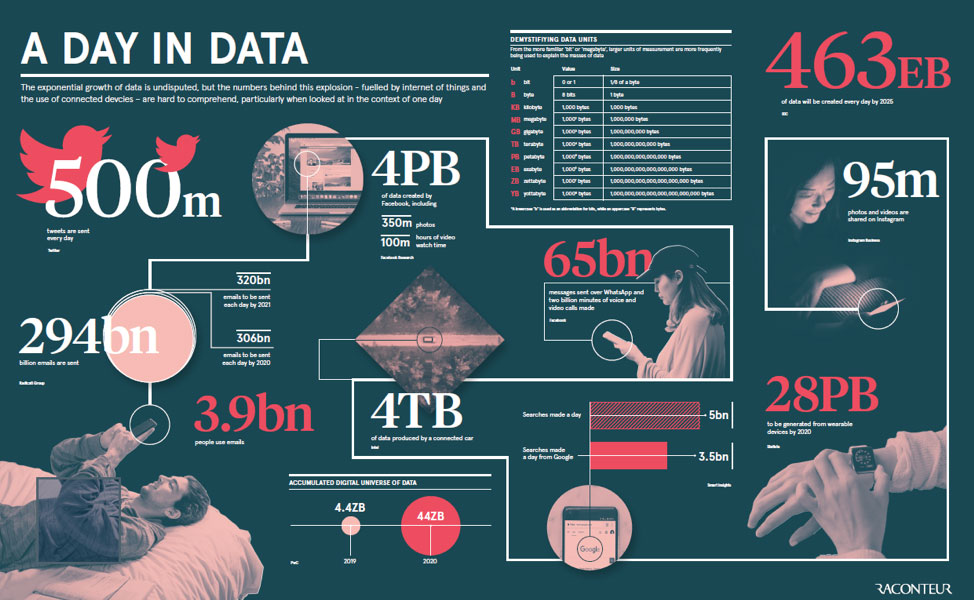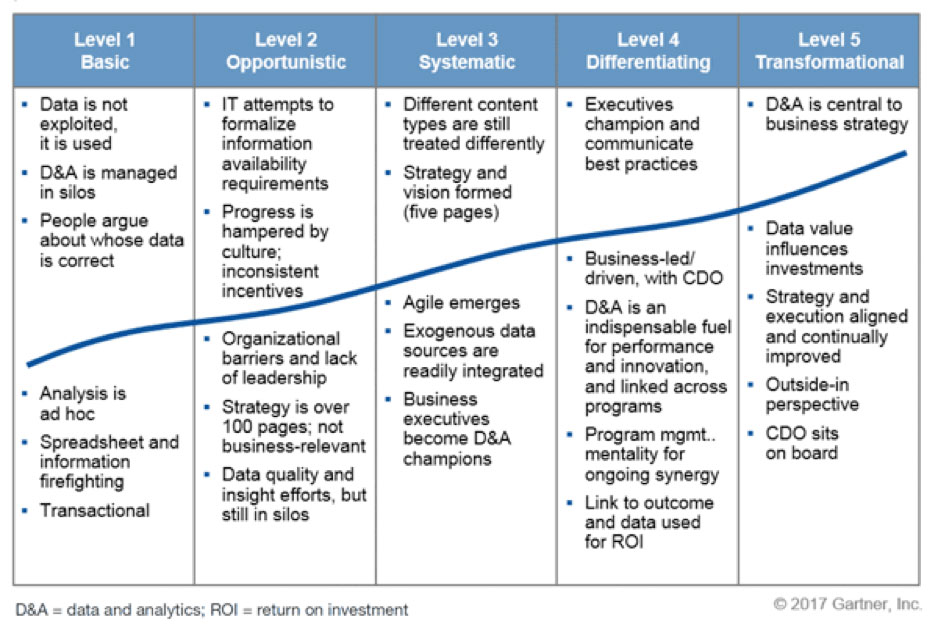People create more data than anyone can truly imagine. Increasingly, machines are creating and sharing even more data every minute of the day. Never before has so much data been created in so many different forms, via so many different sources, for so many multifarious purposes as today.
PwC estimates that 4.4 zetabytes have already accumulated, and there will be 10 times more by next year. Research from IDC reports that by 2025 about 463 exabytes of data will be generated each day.

Image source: Raconteur
Data reveals insights that enable bold business decisions. Data is the foundation for bleeding edge research, development and innovation. Data is the backbone of the multibillion dollar artificial intelligence (AI) and machine learning industries. Data leaks are influencing the fate of democracies. Data tells you if it’s going to rain tomorrow. The list goes on. Big data. Clean data. Corrupt data. Statistical data. Web data.
The underlying point here is simple: Information makes the business world go round today, with the result that data is often treated as a permanent entity that can be retrieved and utilized whenever needed.
However, not all of this data downpour really matters. A lot of the data that individuals and organizations generate every day is just noise. Often data is captured simply because we can. Data that performs no real role in decision making, data that is not bound by regulatory or compliance requirements, data that is often forgotten and sits untouched on servers for decades – all of these simply add to the garbage that goes in, but never comes out (defeating GIGO).
The worst part? Organizations throw away good money after bad data. There is a need for organizations to develop the capabilities to develop a sound data strategy and prioritize the various types of data they collect, store and use.
The Cost of “Useless” Data
It’s not uncommon to see people waste perfectly good shelf space by hanging on to things they haven’t used in years. But when this behavior is extrapolated to the organizational level, the costs of such extravagance add up fast. Research shows that companies could potentially save $62 billion a year by simply making sure they didn’t store useless, unnecessary and unimportant data in the cloud.
Not only is it a direct waste of resources, it also has an opportunity cost attached to it. Businesses dig themselves into a hole by not making good storage available for data that truly matters. Compound this issue with the cost of data errors and poor data quality, and profitability and growth suffer. A report in the MIT Sloan Management Review pegs this figure at 10-15% of revenue for most companies.
Data Maturity and Its Impact on Business Outcomes
How organizations manage the data they generate and work with is a barometer of their data maturity, which in turn is a key contributor to business growth and profitability. Gartner classifies organizations based on their data maturity on a scale of 1 to 5, with 1 being the most basic level of data maturity and 5 being the highest and most transformational level.
At the basic level, data exists in silos and is merely used, not exploited to its full potential. Data analytics is rudimentary using spreadsheets and transactional data is the primary business focus. As one moves along the scale, organizations get better at sharing, analyzing and deriving insights out of data. Leadership becomes data-driven and data analytics becomes an indispensable part of the business, powering growth and sparking innovation.
Image source: Gartner
Unsurprisingly, Gartner’s study spanning 196 organizations across the world reveals that a sizeable 60% of businesses place themselves in the lowest three levels of data maturity. A poor or completely absent data strategy was one of the most common reasons for this lack of data maturity across all surveyed organizations.
Get Strategic About Data
There are some key factors to consider when developing your organization’s data strategy.
Business strategy – A “data strategy” should be a byproduct of a business strategy, not the other way round. “Data management strategies need to align, and be driven by, business strategy.” says Andy Hayler, CEO of The Information Difference, a data consulting firm. While this may seem pretty logical, it’s amazing to see how companies draft data strategies that are completely divorced from the realities of their business, leading to underutilization of data, application of wrong data for key decision making, even data loss due to inefficient or insecure storage options.
Integrity – Another important factor to account for is ensuring complete integrity of company data. This means your data management policy actively prevents errors, omissions, and misinterpretations from creeping into various data sets. All critical data needs to be cleaned and stored for future use, especially data that falls under the purview of regulatory authorities. For this, companies do have good options such as Nutanix’s data protection and disaster recovery technologies, which protect virtualized information from VMs and apps as well as slash operational costs of storage and access.
Access and security – One of the primary functions of a sound data strategy is providing for a balance between data security and accessibility. Preventing data leaks or thefts, while still keeping it easily accessible to the right people at the right time can be tricky but unavoidable. While firewalls and security systems exist for onsite data warehouses, there isn’t enough awareness of security features for data in private and public clouds. Hashing and salting sensitive data like passwords, social security numbers, employment records, and all personally identifiable information should be a basic prerequisite before you store them. Set up two-factor authentication for users and train them in the best practices to create and manage their passwords securely.
Retention – The large-scale adoption of the cloud – public, private or hybrid – for data management, is a clear sign of the reliability, scalability and speed that these storage solutions bring with them. However, a renewed interest in good old magnetic tapes for storing data is a vote of confidence in a medium that’s being upgraded for the times. Ranging from record keeping to compliance, picking the right type of storage option directly impacts costs, data integrity and accessibility.
Cost – Finally, we come down to the bottom line. No matter how exciting a new technology may seem, there is a budget to consider – the CFO will want to weigh it against the opportunity cost of not using it, the type and skill level of the manpower needed to manage it, the supporting infrastructure needed to maintain it, and so on.
Data, like diamonds, cost money. To buy and store.
A good way to rationalize data commitments is to view data as a resource instead of a byproduct of the business. Just as some resources need to be tended to and invested in to show results, sift through and identify the data that has the potential to strengthen, scale and grow the business, while letting go of those that are a drain on the bottom line.
In the wise words of Marie Kondo (who has written four books on organizing), “Visible mess helps distract us from the true source of the disorder.”
Dipti Parmar is a contributing writer. She has written for CIO.com, Entrepreneur, CMO.com and Inc. Magazine. Follow her on Twitter @dipTparmar.
© 2019 Nutanix, Inc. All rights reserved. For additional legal information, please go here.

